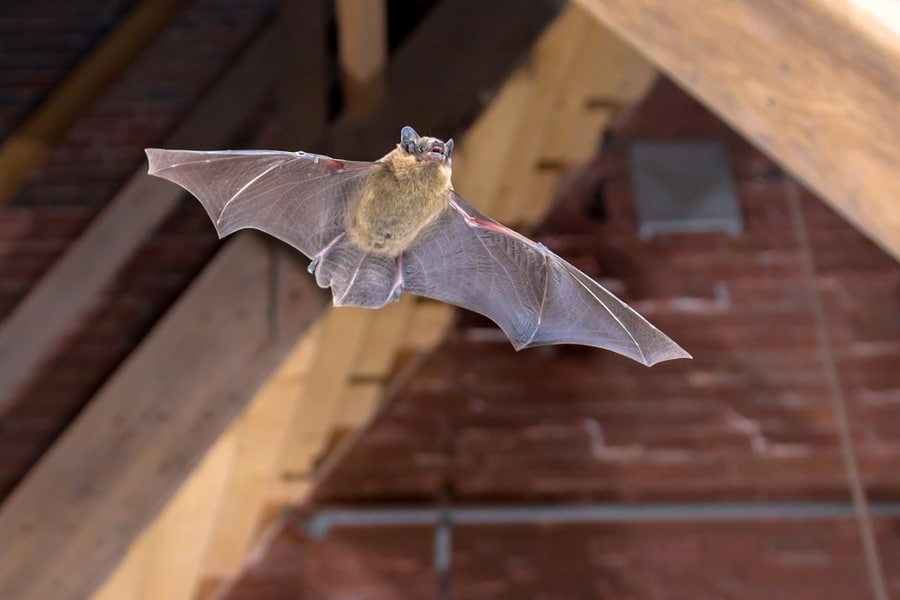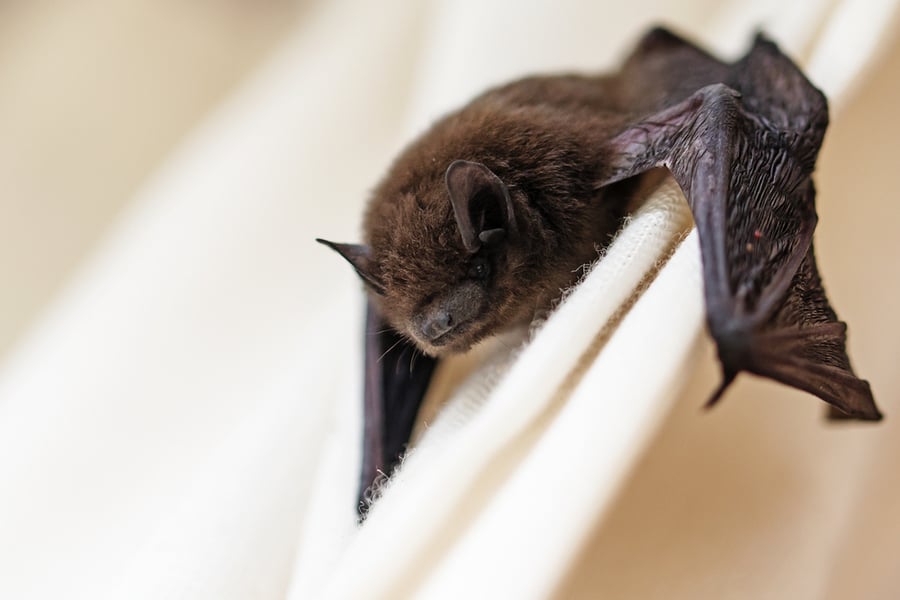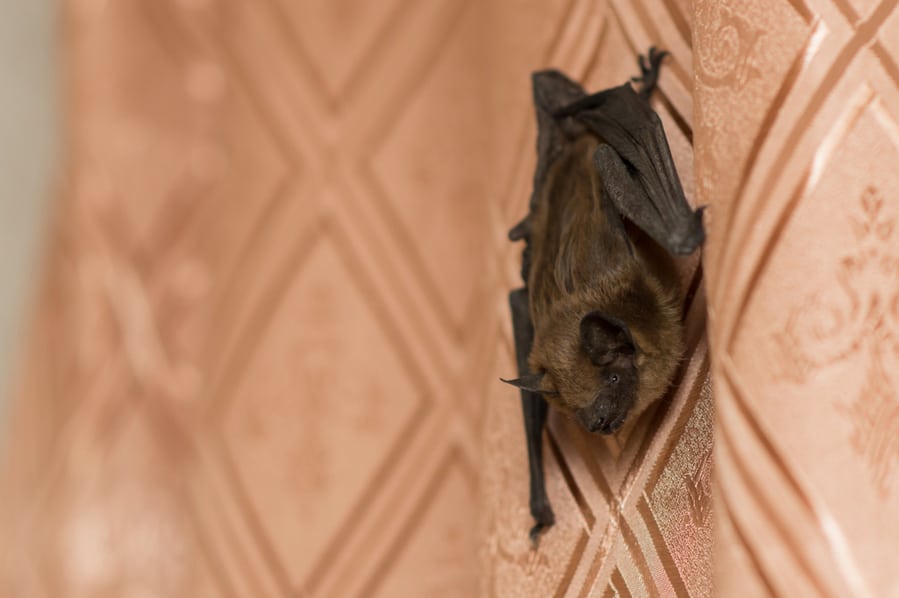
You’ve probably experienced seeing bats inside tunnels when visiting underwater caves or forests, especially at night.
These nocturnal animals love spending time in the dark and at night when everyone is fast asleep.
To most people, having the chance to encounter bats at a glance during their trips may be fun and exciting.
But to homeowners, seeing bats suddenly entering their houses can just become one of their worst nightmares.
While it’s unusual, there can be instances when bats will suddenly enter your property, especially when you live near dark forests. Wouldn’t you feel scared if that happened to you?
Bats are uninvited guests, and they should never be welcomed in whoever’s home. Regardless of the type of bat that enters your room or attic, this step-by-step guide should work in getting the flying animal out:
- Calm yourself down, and don’t panic.
- Wear your protective gear and close the room.
- Clear a potential path where the bat can exit.
- Trap the bat and release.
- Call a professional if needed.
After successfully trapping and releasing the bat, you must ensure other bats or uninvited guests won’t come in.
And if you have a soft spot for creatures like bats, setting up a bat house that can serve as their shelter is also a great way to ensure they have a safe space to nest and care for their young.
Knowing why bats are quick to enter anyone’s house will help you determine how to keep them out.
And in this guide, we’ll teach you how to get these bats to exit your house without harming them.
How Can Bats Enter Your House?

Like humans, bats are curious animals too. When they see potential open spots where they can enter, expect them to probably do so.
Bats will normally fly through open doors or windows of a house, but they are not smart enough to immediately secure a way to get out.
But aside from their curiosity, bats are fond of invading the humans’ living space because they need shelter for their babies, especially during spring or fall.
And because bats are flexible animals, they can enter even holes as small as 3/8 inch! This means these nocturnal animals can enter the gaps in your roof, siding, attic vents, and chimneys.
Moreover, when bats love your home, getting them out would be really challenging unless you get aggressive and trap them.
The Step-by-Step Guide to Getting Bats Out

You’ve finally confirmed a bat is really inside the house. Now, what should you do?
Unlike other pests like roaches and rodents, bats are a little less harmful, so you don’t need to freak out.
No one wants to see a bat inside the room. But if you’re unlucky, follow this step-by-step guide:
1. Calm Yourself Down

First things first. If you want to successfully trap the bat that has entered your house, you must be calm. Often panicking can cause unwanted thoughts that could confuse you about what to do.
Additionally, freaking out may tempt you to get the nearest newspaper and swat the bat. Never give in to that urge. Always remember that bats may look spooky but harmless, especially when you let them be.
Unless they are provoked, bats won’t fly directly toward you and injure you. And unlike the movie scenes, bats are not fond of drinking human blood.
When you see a bat inside your house, imagine it’s a furry little pet like a hamster. Gather your thoughts, and think about how you can lure the animal out.
2. Wear Your Protective Gear and Clear the Room

After you’ve mustered all the courage you need to face the bat, gear up.
Bare hands are a major no during this situation. Get a pair of thick leather gloves and wear them. We also encourage wearing thick layers of clothes and even a face mask in case of unwanted bites.
We keep reiterating that bats are harmless, but it’s always better to be safe than sorry.
Once you have worn all the near, clear the room where the bat is resting. It won’t help if your kids or pets are inside the same area where you’ll let the bat escape.
Moreover, this could cause added stress or unfortunate accidents when your children interact with the bat. That’s why it’s important that you’re the only one facing the bat and let everyone else exit the room.
After letting everyone out, close the door and the windows. You need to secure where the exact location of the bat inside the room and keep an eye on the animal at all times.
If you accidentally lose sight of the bat, search for it in high places, including the following:
- Above the bookshelf
- Curtain rod
- Hanging light fixture
3. Clear a Potential Exit Path for the Bat

After ensuring that everyone except yourself and the bat is out of the room, clear a path for the animal; you must ensure it’s easy for the bat to fly out by providing a clear escape route.
If there are windows or doors, open them as wide as possible, and switch off outside lights near the space where you want the bat to fly out. You can also try to dim the lights inside the room to help the bat calm down.
Once you think the bat has exited, verify by checking high places, similar to what we have suggested.
You can also check behind-wall decorations or check the ground for any sight of an injured bat. For instance, when you see a bat sitting on the floor, it’s easier to trap and catch the animal. So it’s to your advantage.
4. Trap the Bat and Release

If securing a clear exit path won’t work for the bat, maybe it’s time to be a little more aggressive and catch the animal yourself. You can ask for another person to help focus on the bat’s location while you prepare the following materials:
- A broom
- Piece of cardboard
- Plastic bin
Once you’re prepared with your gear and the needed materials, you should wait for the bat to stop flying or become stationary. Remember that stationary bats are the easiest to catch and trap.
Using the broom, you can offer the bat a place to hang. You can do this by resting the broom’s handly where the bat is currently hanging. Frequently, doing this encourages the bat to climb aboard the broom’s handle so you can take it outdoors.
Once you’ve gotten ahold of the bat through the broom, slowly move until you’ve reached the exit, or you can also release the bat through an open window.
If the magic broom fails, you need to be more aggressive. But this time, you need a plastic container instead of a broom. Move closer to the bat, and place the container over it.
Get the thin piece of cardboard you prepared and slide it across the container’s opening. This will keep the bat trapped inside the plastic container as you bring it out.
Aside from a plastic container, using a giant scarf, bedsheet, or any cloth will also work.
5. Call a Professional if Needed

If your DIY methods really won’t work, there’s no harm in calling the experts.
Look for a pest control service that can respond to your emergency situation immediately, or calling wildlife rehabilitators or your state’s local animal control department is possible.
Calling the professionals is also a great idea to ensure you’re free of any bat bite, which could turn into a rabies issue.
Get the Harmless Bats Out of Your House
There you have it. The next time a bat, unfortunately, enters your space, you know what to do.
And because these animals are actually harmless, we also recommend you stay as calm as possible when dealing with bats.
The most essential step to ensuring the bat successfully goes out of your house is not freaking out and securing a clear exit path.
But calling the experts for help is also the right thing to do.
Frequently Asked Questions
Can a Bat Bite Me While I’m Sleeping?
There’s a potential that a bat can bite you while you’re sound asleep.
This is especially common when you have not found out a bat is inside your room and it’s dark. Remember that bats can behave and take action, even during the darkest nights.
What Can Potentially Scare Bats?
Bats are not fond of anything bright, so installing bright lights at home can deter them.
When it comes to scents, these nocturnal animals hate mothballs, eucalyptus, and cinnamon.










